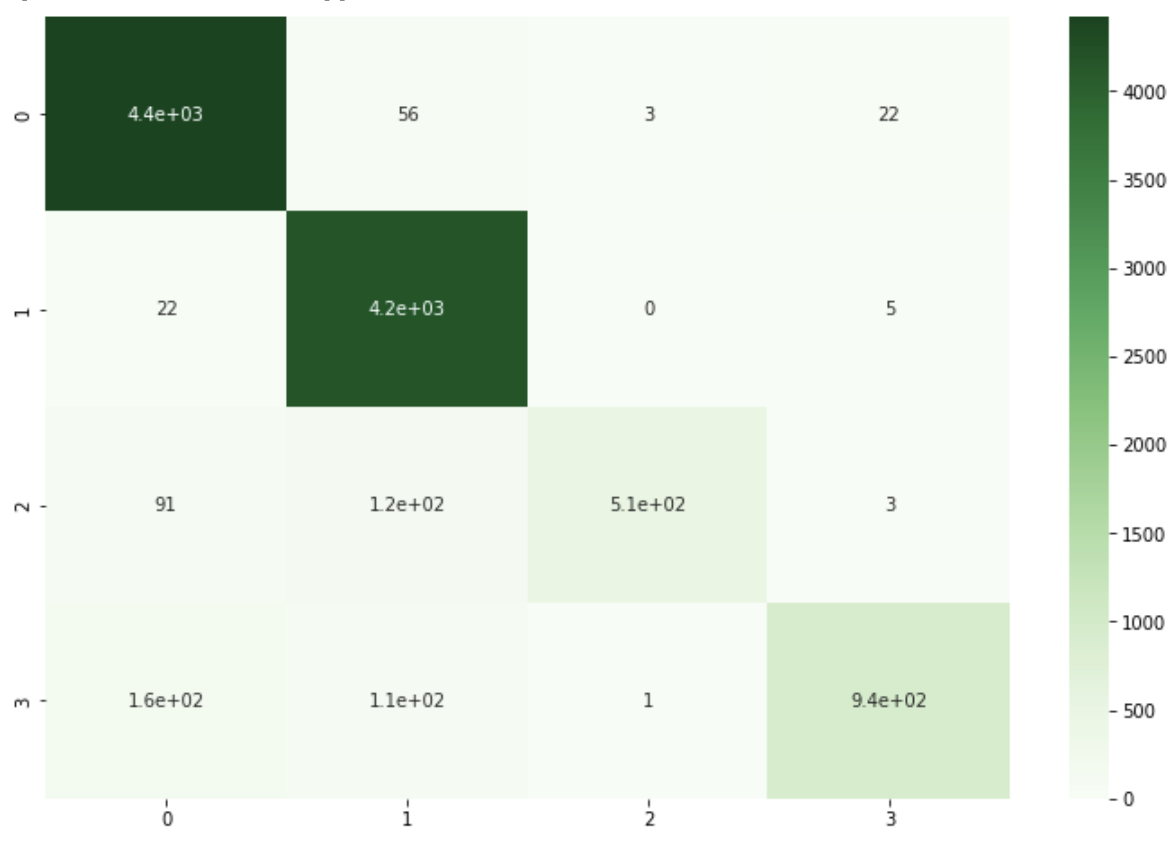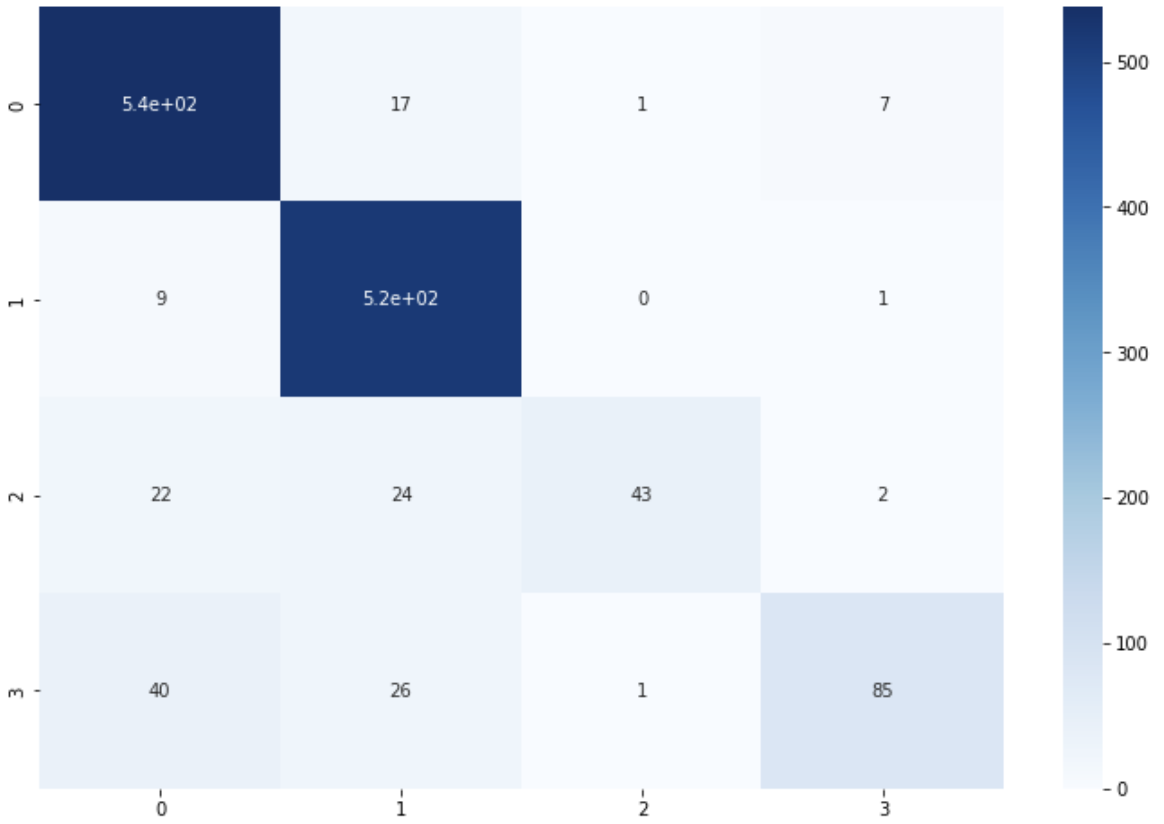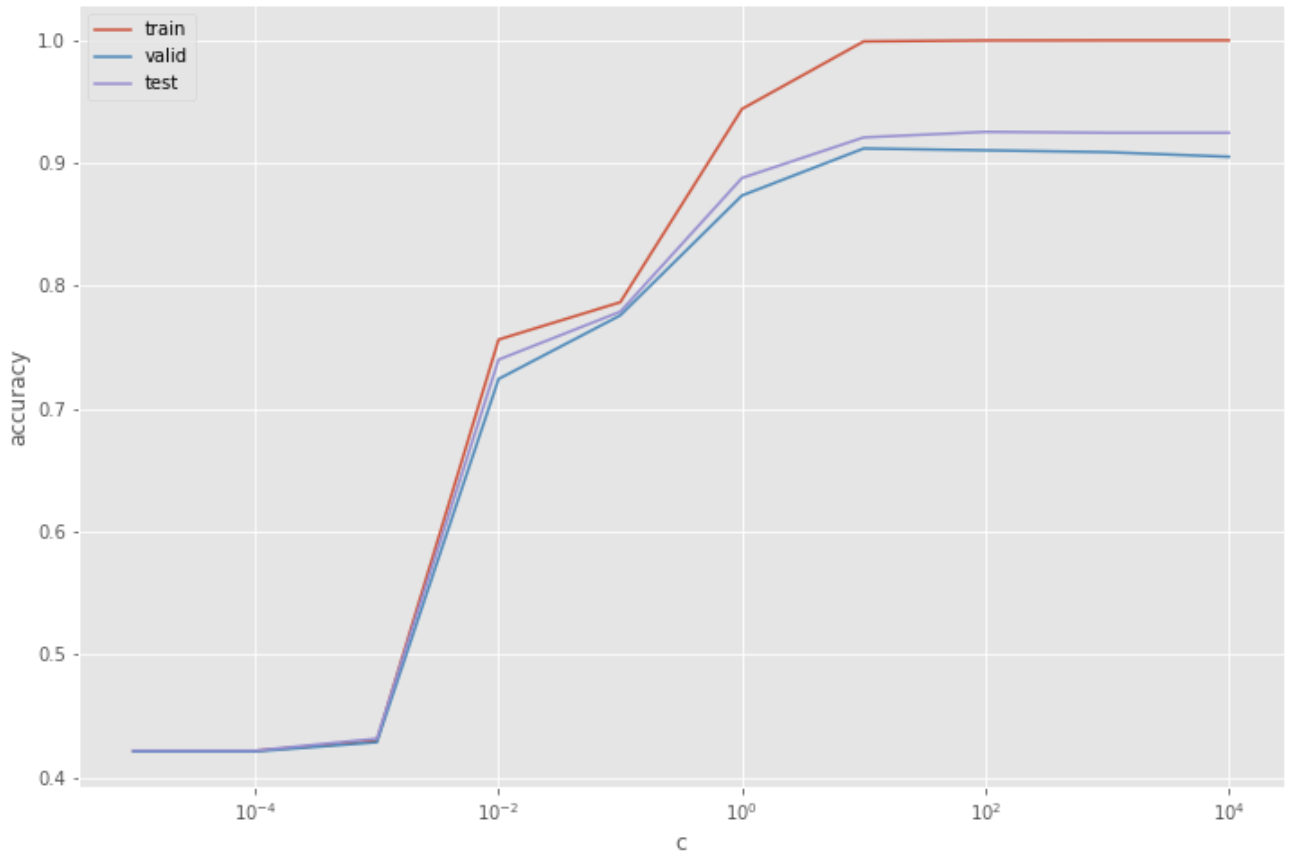Introduction
The Tokyo Institute of Technology has created and maintains a collection of exercises on NLP called "NLP 100 Exercise".
In this article, I will find sample answers to "Chapter 6: Machine Learning".
50. Download and Preprocess Dataset
Download News Aggregator Data Set and create training data (
train.txt), validation data (valid.txt) and test data (test.txt) as follows:
- Unpack the downloaded zip file and read
readme.txt.- Extract the articles such that the publisher is one of the followings: “Reuters”, “Huffington Post”, “Businessweek”, “Contactmusic.com” and “Daily Mail”.
- Randomly shuffle the extracted articles.
- Split the extracted articles in the following ratio: the training data (80%), the validation data (10%) and the test data (10%). Then save them into files
train.txt,valid.txtandtest.txt, respectively. In each file, each line should contain a single instance. Each instance should contain both the name of the category and the article headline. Use Tab to separate each field.After creating the dataset, check the number of instances contained in each category.
!wget https://archive.ics.uci.edu/ml/machine-learning-databases/00359/NewsAggregatorDataset.zip
!unzip ./NewsAggregatorDataset.zip
!wc -l ./newsCorpora.csv
>> 422937 ./newsCorpora.csv
!head -5 ./newsCorpora.csv
>> 1 Fed official says weak data caused by weather, should not slow taper http://www.latimes.com/business/money/la-fi-mo-federal-reserve-plosser-stimulus-economy-20140310,0,1312750.story\?track=rss Los Angeles Times b ddUyU0VZz0BRneMioxUPQVP6sIxvM www.latimes.com 1394470370698
>> 2 Fed's Charles Plosser sees high bar for change in pace of tapering http://www.livemint.com/Politics/H2EvwJSK2VE6OF7iK1g3PP/Feds-Charles-Plosser-sees-high-bar-for-change-in-pace-of-ta.html Livemint b ddUyU0VZz0BRneMioxUPQVP6sIxvM www.livemint.com 1394470371207
>> 3 US open: Stocks fall after Fed official hints at accelerated tapering http://www.ifamagazine.com/news/us-open-stocks-fall-after-fed-official-hints-at-accelerated-tapering-294436 IFA Magazine b ddUyU0VZz0BRneMioxUPQVP6sIxvM www.ifamagazine.com 1394470371550
>> 4 Fed risks falling 'behind the curve', Charles Plosser says http://www.ifamagazine.com/news/fed-risks-falling-behind-the-curve-charles-plosser-says-294430 IFA Magazine b ddUyU0VZz0BRneMioxUPQVP6sIxvM www.ifamagazine.com 1394470371793
>> 5 Fed's Plosser: Nasty Weather Has Curbed Job Growth http://www.moneynews.com/Economy/federal-reserve-charles-plosser-weather-job-growth/2014/03/10/id/557011 Moneynews b ddUyU0VZz0BRneMioxUPQVP6sIxvM www.moneynews.com 1394470372027
import pandas as pd
df = pd.read_csv(
'./newsCorpora.csv',
header=None,
sep='\t',
names=['ID', 'TITLE', 'URL', 'PUBLISHER', 'CATEGORY', 'STORY', 'HOSTNAME', 'TIMESTAMP']
)
# extract data
df = df.loc[df['PUBLISHER'].isin(['Reuters', 'Huffington Post', 'Businessweek', 'Contactmusic.com', 'Daily Mail']), ['TITLE', 'CATEGORY']]
print(df.sample(5))
>> TITLE CATEGORY
>> 360406 David Arquette gets engaged to Christina McLarty e
>> 110548 Beyonce - Beyonce Makes Surprise Appearance At... e
>> 266665 Airlines struggling to break even will make 'l... b
>> 100350 $84000 For A 12-Week Treatment? Pharma Trade G... m
>> 20232 Study To Test 'Chocolate Pills' For Heart Health m
from sklearn.model_selection import train_test_split
# split data
train, valid_test = train_test_split(
df,
test_size=0.2,
shuffle=True,
random_state=42,
stratify=df['CATEGORY']
)
valid, test = train_test_split(
valid_test,
test_size=0.5,
shuffle=True,
random_state=42,
stratify=valid_test['CATEGORY']
)
# save data
train.to_csv('./train.txt', sep='\t', index=False)
valid.to_csv('./valid.txt', sep='\t', index=False)
test.to_csv('./test.txt', sep='\t', index=False)
# count
print('train', train.shape)
print(train['CATEGORY'].value_counts())
print('\n')
print('valid', valid.shape)
print(valid['CATEGORY'].value_counts())
print('\n')
print('test', test.shape)
print(test['CATEGORY'].value_counts())
train (10672, 2)
b 4502
e 4223
t 1219
m 728
Name: CATEGORY, dtype: int64
valid (1334, 2)
b 562
e 528
t 153
m 91
Name: CATEGORY, dtype: int64
test (1334, 2)
b 563
e 528
t 152
m 91
Name: CATEGORY, dtype: int64
51. Feature extraction
Extract a set of features from the training, validation and test data, respectively. Save the features into files as follows:
train.feature.txt,valid.feature.txtandtest.feature.txt. Design the features that are useful for the news classification. The minimum baseline for the features is the tokenized sequence of the news headline.
import string
import re
from sklearn.feature_extraction.text import TfidfVectorizer
from sklearn.model_selection import train_test_split
def preprocess(text):
text = "".join([i for i in text if i not in string.punctuation])
text = text.lower()
text = re.sub("[0-9]+", "", text)
return text
df = pd.concat([train, valid, test], axis=0)
df.reset_index(drop=True, inplace=True)
df["TITLE"] = df["TITLE"].map(lambda x: preprocess(x))
# split data
train_valid = df[:len(train) + len(valid)]
test = df[len(train) + len(valid):]
# tfidf vectorizer
vec_tfidf = TfidfVectorizer()
# vectorize
x_train_valid = vec_tfidf.fit_transform(train_valid["TITLE"])
x_test = vec_tfidf.transform(test["TITLE"])
# convert vector to df
x_train_valid = pd.DataFrame(x_train_valid.toarray(), columns=vec_tfidf.get_feature_names())
x_test = pd.DataFrame(x_test.toarray(), columns=vec_tfidf.get_feature_names())
# split train and valid
x_train = x_train_valid[:len(train)]
x_valid = x_train_valid[len(train):]
x_train.to_csv('train.feature.txt', sep='\t', index=False)
x_valid.to_csv('valid.feature.txt', sep='\t', index=False)
x_test.to_csv('test.feature.txt', sep='\t', index=False)
print(x_train.sample(5))
aa aaa aaliyah aaliyahs aaron aatha abandon abandoned \
10403 0.0 0.0 0.0 0.0 0.0 0.0 0.0 0.0
5795 0.0 0.0 0.0 0.0 0.0 0.0 0.0 0.0
2506 0.0 0.0 0.0 0.0 0.0 0.0 0.0 0.0
6052 0.0 0.0 0.0 0.0 0.0 0.0 0.0 0.0
2967 0.0 0.0 0.0 0.0 0.0 0.0 0.0 0.0
abandoning abating ... zone zooey zoosk zs zuckerberg zynga \
10403 0.0 0.0 ... 0.0 0.0 0.0 0.0 0.0 0.0
5795 0.0 0.0 ... 0.0 0.0 0.0 0.0 0.0 0.0
2506 0.0 0.0 ... 0.0 0.0 0.0 0.0 0.0 0.0
6052 0.0 0.0 ... 0.0 0.0 0.0 0.0 0.0 0.0
2967 0.0 0.0 ... 0.0 0.0 0.0 0.0 0.0 0.0
œfck œlousyâ œpiece œwaist
10403 0.0 0.0 0.0 0.0
5795 0.0 0.0 0.0 0.0
2506 0.0 0.0 0.0 0.0
6052 0.0 0.0 0.0 0.0
2967 0.0 0.0 0.0 0.0
[5 rows x 14596 columns]
52. Training
Use the training data from the problem 51 and train the logistic regression model.
from sklearn.linear_model import LogisticRegression
import pickle
model = LogisticRegression(random_state=42, max_iter=10000)
model.fit(x_train, train['CATEGORY'])
pickle.dump(model, open('model.pkl', 'wb'))
53. Prediction
Use the logistic regression model from the problem 52. Create a program that predicts the category of a given news headline and computes the prediction probability of the model.
print(f"category:{model.classes_}\n")
Y_pred = model.predict(x_valid)
print(f"true (valid):{valid['CATEGORY'].values}")
print(f"pred (valid):{Y_pred}\n")
Y_pred = model.predict_proba(x_valid)
print('predict_proba (valid):\n', Y_pred)
>> category:['b' 'e' 'm' 't']
>>
>> true (valid):['b' 'b' 'b' ... 'e' 'b' 'b']
>> pred (valid):['b' 'b' 'b' ... 'e' 'b' 'b']
>>
>> predict_proba (valid):
>> [[0.62771515 0.24943257 0.05329437 0.06955792]
>> [0.95357611 0.02168835 0.01076999 0.01396555]
>> [0.62374248 0.19986725 0.04322305 0.13316722]
>> ...
>> [0.07126101 0.8699611 0.02801506 0.03076283]
>> [0.97913656 0.01028849 0.00375249 0.00682247]
>> [0.9814316 0.00655014 0.00383028 0.00818798]]
54. Accuracy score
Compute the accuracy score of the logistic regression model from the problem 52 on both the training data and the test data.
from sklearn.metrics import accuracy_score
y_pred_train = model.predict(x_train)
y_pred_test = model.predict(x_test)
print(f"train accuracy:{accuracy_score(train['CATEGORY'], y_pred_train): .3f}")
print(f"test accuracy:{accuracy_score(test['CATEGORY'], y_pred_test): .3f}")
train accuracy: 0.944
test accuracy: 0.888
55. Confusion matrix
Create the confusion matrix of the logistic regression model from the problem 52 for both the training data and the test data.
from sklearn.metrics import confusion_matrix
import seaborn as sns
import matplotlib.pyplot as plt
# train data
train_cm = confusion_matrix(train['CATEGORY'], y_pred_train)
print(train_cm)
plt.figure(figsize=(12, 8))
sns.heatmap(train_cm, annot=True, cmap='Greens')
plt.show()
[[4421 56 3 22]
[ 22 4196 0 5]
[ 91 125 509 3]
[ 162 111 1 945]]

# test data
test_cm = confusion_matrix(test['CATEGORY'], y_pred_test)
print(test_cm)
plt.figure(figsize=(12, 8))
sns.heatmap(test_cm, annot=True, cmap='Blues')
plt.show()
[[538 17 1 7]
[ 9 518 0 1]
[ 22 24 43 2]
[ 40 26 1 85]]

56. Precision, recall and F1 score
Compute the precision, recall and F1 score of the logistic regression model from the problem 52. First, compute these metrics for each category. Then summarize the score of each category using (1) micro-average and (2) macro-average.
from sklearn.metrics import precision_score, recall_score, f1_score
import numpy as np
# precision
precision = precision_score(test['CATEGORY'], y_pred_test, average=None, labels=model.classes_)
precision = np.append(precision, precision_score(test['CATEGORY'], y_pred_test, average='micro'))
precision = np.append(precision, precision_score(test['CATEGORY'], y_pred_test, average='macro'))
# recall
recall = recall_score(test['CATEGORY'], y_pred_test, average=None, labels=model.classes_)
recall = np.append(recall, recall_score(test['CATEGORY'], y_pred_test, average='micro'))
recall = np.append(recall, recall_score(test['CATEGORY'], y_pred_test, average='macro'))
# F1
f1 = f1_score(test['CATEGORY'], y_pred_test, average=None, labels=['b', 'e', 't', 'm'])
f1 = np.append(f1, f1_score(test['CATEGORY'], y_pred_test, average='micro'))
f1 = np.append(f1, f1_score(test['CATEGORY'], y_pred_test, average='macro'))
scores = pd.DataFrame({'precision': precision, 'recall': recall, 'F1': f1},
index=['b', 'e', 't', 'm', 'micro avg', 'macro avg'])
print(scores)
precision recall f1
b 0.883415 0.955595 0.918089
e 0.885470 0.981061 0.930818
t 0.955556 0.472527 0.688259
m 0.894737 0.559211 0.632353
micro avg 0.887556 0.887556 0.887556
macro avg 0.904794 0.742098 0.792380
57. Feature weights
Use the logistic regression model from the problem 52. Check the feature weights and list the 10 most important features and 10 least important features.
features = x_train.columns.values
index = [i for i in range(1, 11)]
for c, coef in zip(model.classes_, model.coef_):
print(f'category: {c}', '*' * 100)
best_10 = pd.DataFrame(features[np.argsort(coef)[::-1][:10]], columns=['best 10'], index=index).T
worst_10 = pd.DataFrame(features[np.argsort(coef)[:10]], columns=['worst 10'], index=index).T
print(pd.concat([best_10, worst_10], axis=0))
print('\n')
category: b ****************************************************************************************************
1 2 3 4 5 6 7 8 9 \
best 10 fed bank ecb china oil ukraine euro update stocks
worst 10 and the her ebola facebook she video study kardashian
10
best 10 buy
worst 10 google
category: e ****************************************************************************************************
1 2 3 4 5 6 7 8 9 \
best 10 kardashian chris kim she her cyrus miley star paul
worst 10 update us google says ceo study billion china could
10
best 10 movie
worst 10 facebook
category: m ****************************************************************************************************
1 2 3 4 5 6 7 8 \
best 10 ebola cancer study drug fda mers health virus
worst 10 gm facebook climate ceo apple twitter deal google
9 10
best 10 could heart
worst 10 sales buy
category: t ****************************************************************************************************
1 2 3 4 5 6 7 \
best 10 google facebook apple climate microsoft gm tmobile
worst 10 her at drug fed but american shares
8 9 10
best 10 samsung heartbleed tesla
worst 10 cancer bank stocks
58. Regularization
When training a logistic regression model, one can control the degree of overfitting by manipulating the regularization parameters. Use different regularization parameters to train the model. Then, compute the accuracy score on the training data, validation data and test data. Summarize the results on the graph, where x-axis is the regularization parameter and y-axis is the accuracy score.
from tqdm import tqdm
import matplotlib.pyplot as plt
plt.style.use('ggplot')
c_list = np.logspace(-5, 4, 10, base=10)
# models = [LogisticRegression(C=C, random_state=42, max_iter=1000).fit(x_train, train['CATEGORY']) for C in tqdm(c_list)]
train_accs = [accuracy_score(model.predict(x_train), train['CATEGORY']) for model in models]
valid_accs = [accuracy_score(model.predict(x_valid), valid['CATEGORY']) for model in models]
test_accs = [accuracy_score(model.predict(x_test), test['CATEGORY']) for model in models]
plt.plot(c_list, train_accs, label = 'train')
plt.plot(c_list, valid_accs, label = 'valid')
plt.plot(c_list, test_accs, label = 'test')
plt.xscale('log')
plt.xlabel('c')
plt.ylabel('accuracy')
plt.legend()
plt.show()

59. Hyper-parameter tuning
Use different training algorithms and parameters to train the model for the news classification. Search for the training algorithms and parameters that achieves the best accuracy score on the validation data. Then compute its accuracy score on the test data.
!pip install optuna
import optuna
def objective(trial):
model = LogisticRegression(random_state=42,
max_iter=10000,
penalty='elasticnet',
solver='saga',
l1_ratio=trial.suggest_uniform('l1_ratio', 0, 1),
C=trial.suggest_loguniform('C', 1e-4, 1e2))
model.fit(x_train, train['CATEGORY'])
valid_accuracy = accuracy_score(model.predict(x_valid), valid['CATEGORY'])
return valid_accuracy
study = optuna.create_study(direction='maximize')
study.optimize(objective, n_trials=2, timeout=3600)
print('Best trial:')
trial = study.best_trial
print(' Value: {:.3f}'.format(trial.value))
print(' Params: ')
for key, value in trial.params.items():
print(' {}: {}'.format(key, value))
>> Best trial:
>> Value: 0.657
>> Params:
>> l1_ratio: 0.8173726339927334
>> C: 0.08584685734174859
model = LogisticRegression(random_state=42,
max_iter=10000,
penalty='elasticnet',
solver='saga',
l1_ratio=trial.params['l1_ratio'],
C=trial.params['C'])
model.fit(x_train, train['CATEGORY'])
y_pred_train = model.predict(x_train)
y_pred_valid = model.predict(x_valid)
y_pred_test = model.predict(x_test)
train_accuracy = accuracy_score(train['CATEGORY'], y_pred_train)
valid_accuracy = accuracy_score(valid['CATEGORY'], y_pred_valid)
test_accuracy = accuracy_score(test['CATEGORY'], y_pred_test)
print(f'accuracy (train):{train_accuracy:.3f}')
print(f'accuracy (valid):{valid_accuracy:.3f}')
print(f'accuracy (test):{test_accuracy:.3f}')
>> accuracy (train):0.668
>> accuracy (valid):0.657
>> accuracy (test):0.653
References